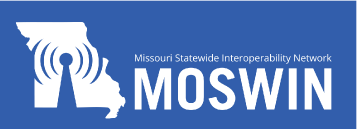Difference between revisions of "Missouri Statewide Wireless Interoperable Network (MOSWIN)"
From The RadioReference Wiki
| Line 42: | Line 42: | ||
---- | ---- | ||
=== Project 25 Subscriber Radio Requirements === | === Project 25 Subscriber Radio Requirements === | ||
| − | * [https://dps.mo.gov/dir/programs/intercomm/docs/Project25.pdf P25 PDF] <pre> | + | * [https://dps.mo.gov/dir/programs/intercomm/docs/Project25.pdf P25 PDF] |
| + | <pre> | ||
Device must be capable of Advanced Project 25 Control Channel | Device must be capable of Advanced Project 25 Control Channel | ||
functionality that enables explicit trunking. Due to the lack of standardized | functionality that enables explicit trunking. Due to the lack of standardized | ||
Revision as of 17:18, 20 January 2024
Return to MOSWIN Trunked System Database page
Return to Wiki page: Trunked Radio Systems (MO), Trunked Radio Systems (IL)
Also see Missouri Department of Public Safety Wiki page or Database page
Contents
NOTE
- There are currently NO Phase 2 talkgroups or Phase 2 capable towers (But some towers "report" as Phase 2 capable via pro96com) DISREGARD THE PHASE II NOTE BELOW
Wiki Home → Collaboration Gateway → United States → Missouri, Illinois → Missouri Statewide Wireless Interoperable Network (MOSWIN) TRS
Welcome to the Missouri Statewide Wireless Interoperable Network (MOSWIN) collaboration article, a Multi-State Public Trunked Radio System located in Missouri, Illinois, United States.
This is where you, the user, may index any articles you develop for scanning related topics for this Trunked Radio System.
- Some talkgroups on this system may be using P25 Phase II TDMA modulation, which can only be monitored using a P25 Phase II capable scanner or receiver.
- Click HERE for a list of scanners capable of monitoring those talkgroups.
Information
The capability to communicate across jurisdictional and discipline lines (interoperability of communications) is one of the top priorities of Missouri’s homeland security program. Ensuring that neighboring jurisdictions and multiple disciplines can communicate with each other leads to better emergency and disaster response and ultimately makes for safer communities.
Missouri has built a statewide public safety interoperable communications system, known as the Missouri Statewide Interoperability Network (MOSWIN). MOSWIN is a network of communications towers, base stations and communications software. The project is providing the infrastructure that will provide interoperable communications throughout the state to both state public safety agencies and any local jurisdictions that wish to use the system for their interoperable communications. The system meets a Federal Communications Commission mandate that all public safety agencies in the U.S. operate only in a “narrowband” mode after Jan. 1, 2013.
The Statewide Interoperability Network serves two primary functions:
- Missouri Interoperable Communications tower
- Providing internal communications capabilities for state agencies, including the Missouri State Highway Patrol, Department of Natural Resources and State Emergency Management Agency.
- Providing a statewide interoperability platform and access for local agencies to achieve interoperable communications with local, state, regional and federal agencies.
The network operates five channels per site in the “trunked” radio mode and utilizes predominantly VHF High Band public safety spectrum (150 MHz) consisting of 75 radio sites statewide. For more information about MOSWIN email moswin.sysadmin@dps.mo.gov or contact the Missouri Interoperability Center.
Talkgroups
- Site Information (including LCNs) from Pro96com, DSD+
- Miscellaneous Info and Unidentified/Former Talkgroups
- Numerical listing of talkgroups, with users and some RIDs
Radio/Unit IDs (RIDs/UIDs)
Project 25 Subscriber Radio Requirements
Device must be capable of Advanced Project 25 Control Channel functionality that enables explicit trunking. Due to the lack of standardized channel pairings in the public safety VHF High Band spectrum allocation, higher tier P 25 control channel functionality is required in subscriber devices on the MOSWIN network for it to be able to explicitly trunk and specifically assign unique, site based VHF channel pairings to a subscriber radio based on channels available, thereby enabling the subscriber to access the network. This specific method of granting a channel is a more extensive process for the network’s Control Channel than in implicit trunking, where the channel pairings are standardized and a reduced amount of messaging on the Control Channel dedicated to channel granting is required for each channel assignment. In addition to the above criteria, subscriber units proposed for use on MOSWIN need to be tested on the MOSWIN network to ensure consistent operation. Experience in other states, using both VHF High Band and 700/800 MHz Wide Area trunked systems, indicates that field testing of subscriber units prior to system certification is necessary to ensure that the full functionality of the subscriber is achievable and expectations of the users are verified. Those field tests include roaming throughout a system to ensure the subscriber transfers across all the zones of a system and we look forward to working with the vendor community on developing those tests.
Bandplan
- Bandplan #0: Base=851.00625 Offset=-45 Spacing=6.25 BW=12.5
- Bandplan #1: Base=762.00625 Offset=+30 Spacing=6.25 BW=12.5
- Bandplan #2: Base=851.01250 Offset=-45 Spacing=12.5 BW=12.5 Slots=2
- Bandplan #3: Base=762.00625 Offset=+30 Spacing=12.5 BW=12.5 Slots=2
- Bandplan #4: Base=136.00000 Offset=-4.6 Spacing=12.5 BW=12.5
- Bandplan #5: Base=142.42500 Offset=+5.26 Spacing=5.00 BW=12.5
- Bandplan #6: Base=145.32000 Offset=-1.6 Spacing=5.00 BW=12.5
- Bandplan #7: Base=140.11500 Offset=+3.465 Spacing=7.50 BW=12.5
- Bandplan #8: Base=139.57500 Offset=+3.885 Spacing=7.50 BW=12.5
- Bandplan #9: Base=137.27750 Offset=+0.9 Spacing=7.50 BW=12.5
- Bandplan #10: Base=136.00625 Offset=-4.6 Spacing=12.5 BW=12.5
700 Mhz Site Templates/DVRS (Vehicular Repeaters)
- See this Google Document
Maps
- MOSWIN-2021.zip - Contains a Google Earth .kml map of MOSWIN sites.
Related Wiki Articles
- MOSWIN FCC Frequency Applications
- MOSWIN 700 Mhz Buildout
- MOSWIN Programming for Scanners
- MOSWIN Past News Updates
- Missouri Department of Public Safety (MO)
